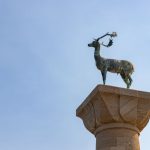Architecture of Acropolis of Rhodes: Balancing Stone and Terrain
April 14, 2025
Sanctuary of the Huntress: Temple of Artemis in Rhodes
April 22, 2025Table of Contents
Introduction
The lasting values that the Acropolis of Rhodes embodied are what define its cultural legacy, not its walls or fortifications. The Acropolis, perched atop Monte Smith with a view of the island’s capital’s harbors, symbolized Rhodes’ spirit.
It was a haven where musicians performed, philosophers discussed, athletes trained and competed, and gods were worshipped. It was more than just broken columns and stone foundations; it was a thoughtfully planned expression of religious devotion, artistic sophistication, and civic pride.
The cultural legacy of the Acropolis of Rhodes became the vibrant center of Rhodian identity by fusing religious sites with intellectual and athletic endeavors, creating a cultural legacy that still captivates tourists centuries later.
A Civic and Sacred Heart

The Doric Temple of Apollo Pythios, a representation of governmental authority and divine authority, was located atop the Acropolis. Along with Helios, the island’s patron deity, Athena, and Zeus, Apollo was revered as the guardian of justice and harmony. These deities united to form a pantheon of gods that protected the city.
This location was used for religious ceremonies, oaths, and processions, confirming the connection between governmental stability and divine favor. The Acropolis was openly connected to the city below rather than concealed behind walls, demonstrating Rhodes’ self-confidence in both its gods and its own wealth.
With faith entwined with governance, law, and the common values of the populace, this sacred heart became the center of the community.
Athletic Pride and Festivals

The athletic and ceremonial areas were equally significant to the cultural heritage of the Acropolis of Rhodes. Particularly during the Halieia festival in honor of Helios, competitions like footraces and chariot races were held in the historic stadium that was carved into the slope of Monte Smith.
By fusing religious devotion with athletic discipline, these games produced a spectacle that strengthened civic devotion and pride. With its colonnaded courtyards, the gymnasium prepared young men for both public life and military service by teaching them moral and intellectual skills in addition to physical strength.
Rhodes believed that civic duty and physical prowess were inextricably linked, and athletics played a crucial role in creating ideal citizens.
Superiority in Art and Thought
The Acropolis fostered the spirit and intellect as well. Scrolls of philosophy, law, and literature were kept in the library, which preserved knowledge and bolstered Rhodes’ standing as a hub for diplomacy and rhetoric. The sounds of poetry, music, and public discussion filled the roofed Odeon theater.
Language and performance were praised here as vital components of civic culture. Education in Rhodes was not limited to classrooms; rather, it was integrated into the Acropolis’s very layout, with young men attending recitals after festivals or studying philosophy after training for athletic events.
This combination of artistic and intellectual endeavors made the city one of the most sophisticated cultural hubs of the Hellenistic world, where winning at the stadium was as highly valued as superior thinking.
A Persistent Impact Throughout Time

The cultural legacy of the Acropolis of Rhodes went beyond its time. Many buildings remained in use during the Roman era, adapting to changing preferences while maintaining their primary functions.
The temples continued to hold their symbolic power, the stadium continued to host competitions, and the Odeon continued to serve as a stage for elegant performances. However, as Rhodes deteriorated over time, it was gradually abandoned, and many of its monuments were destroyed by natural disasters.
However, despite its ruin, the Acropolis remained a symbol of the Rhodian spirit’s principles of harmony, proportion, and civic pride. For contemporary tourists, the location is more than just an archaeological landmark; it is a place where the principles of harmony between the body, mind, and faith that constituted an extraordinary civilization can still be felt.
Conclusion
The cultural legacy of Rhodes’ Acropolis reveals a city that aimed for excellence in all facets of life. The Acropolis represented the harmony between religion, sport, and education that was central to Rhodian identity by bringing together hallowed temples, sports facilities, and educational facilities.
There, people worshipped the gods, played games, developed their wisdom, and appreciated the arts. The Acropolis’ legacy endures, reminding us of a society that felt true greatness emerged from harmony between the divine, the civic, and the human, even though centuries of change have left only fragments.


